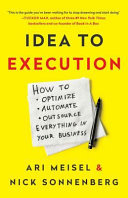

The book emphasizes that every successful venture begins with a solid idea. Ideation is not merely about brainstorming but involves a structured approach to identifying problems worth solving. The author argues that entrepreneurs should focus on understanding market needs and consumer pain points to generate ideas that are not only innovative but also viable in the marketplace. Techniques such as design thinking and customer interviews are highlighted as essential tools in the ideation phase. By validating ideas early through feedback, entrepreneurs can refine their concepts and ensure they are addressing real-world challenges. This iterative process of ideation helps in minimizing risks and aligning the product with market demands.
Continue readingOnce an idea is deemed viable, the next step is to create a prototype. The book outlines the significance of prototyping as a means of bringing ideas to life. Prototypes allow entrepreneurs to test their concepts in real-world scenarios, gather user feedback, and make necessary adjustments before full-scale production. The author discusses various prototyping techniques, from low-fidelity sketches to high-fidelity digital models. The key takeaway is that prototyping is not just about creating a physical product but about validating assumptions and iterating based on user interactions. This process fosters innovation and accelerates the development cycle while ensuring that the final product meets user expectations.
Continue readingThe concept of a Minimum Viable Product (MVP) is central to the book's narrative. An MVP is a version of a product that includes only the essential features necessary to satisfy early adopters and gather feedback for future development. The author emphasizes that launching an MVP allows entrepreneurs to enter the market quickly, test their ideas, and iterate based on real user data. This lean approach reduces costs and risks associated with product development. The book provides case studies of successful companies that started with MVPs and evolved their offerings based on user feedback, illustrating the importance of agility and responsiveness in the product development process.
Continue readingMarket validation is a critical step in the journey from idea to execution. The author explains that entrepreneurs must actively seek feedback from potential customers to validate their product-market fit. This involves conducting surveys, interviews, and beta testing to understand user needs and preferences. The book highlights the importance of data-driven decision-making and the use of analytics to assess market demand. By engaging with customers early and often, entrepreneurs can refine their products and ensure they are meeting market needs. The author stresses that market validation is not a one-time event but an ongoing process that should continue even after the product launch.
Continue readingThe transition from a validated idea to execution requires strategic planning. The book outlines a framework for developing a business plan that includes setting clear goals, defining key performance indicators (KPIs), and outlining a roadmap for execution. The author emphasizes that effective execution is as important as having a great idea. This involves assembling the right team, allocating resources efficiently, and maintaining focus on the company's vision. The book provides insights into project management methodologies, such as Agile and Scrum, which can help teams stay organized and responsive to changes. The importance of adaptability and continuous learning in the execution phase is also highlighted.
Continue readingThe success of any venture hinges on the strength of its team. The author discusses the qualities of effective teams and the importance of fostering a collaborative culture. Building a diverse team with complementary skills can enhance creativity and problem-solving capabilities. The book emphasizes the need for clear communication, trust, and shared vision among team members. The author also provides strategies for recruiting talent, onboarding new hires, and maintaining team morale during challenging times. Leadership plays a crucial role in team dynamics, and the book offers insights into effective leadership styles that can inspire and motivate teams to achieve their goals.
Continue readingOnce a product has gained traction, the focus shifts to scaling the business. The book discusses various growth strategies, including market penetration, product expansion, and diversification. The author highlights the importance of understanding the market landscape and identifying opportunities for growth. Scaling requires careful planning and resource allocation to ensure sustainable growth. The book also touches on the challenges of scaling, such as maintaining quality and managing increased operational complexities. Entrepreneurs are encouraged to adopt a growth mindset and be prepared to pivot their strategies as market conditions change.
Continue reading